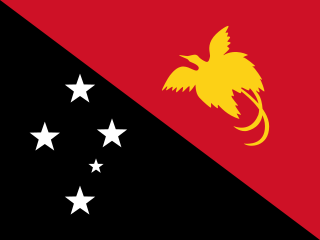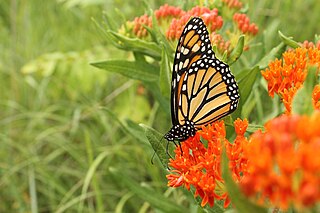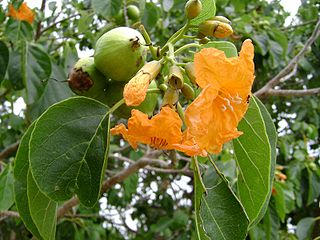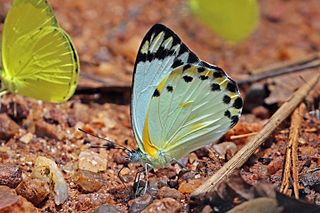
Papua New Guinea, officially the Independent State of Papua New Guinea, is a country in Oceania that comprises the eastern half of the island of New Guinea and its offshore islands in Melanesia. It shares its only land border with Indonesia to the west and its other close neighbors are Australia to the south and the Solomon Islands to the east. Its capital, located on its southern coast, is Port Moresby. The country is the world's third largest island country, with an area of 462,840 km2 (178,700 sq mi).

Butterflies are winged insects from the lepidopteran suborder Rhopalocera, characterized by large, often brightly coloured wings that often fold together when at rest, and a conspicuous, fluttering flight. The group comprises the superfamilies Hedyloidea and Papilionoidea. The oldest butterfly fossils have been dated to the Paleocene, about 56 million years ago, though they likely originated in the Late Cretaceous, about 101 million years ago.

Citrus is a genus of flowering trees and shrubs in the family Rutaceae. Plants in the genus produce citrus fruits, including important crops such as oranges, mandarins, lemons, grapefruits, pomelos, and limes.

The monarch butterfly or simply monarch is a milkweed butterfly in the family Nymphalidae. Other common names, depending on region, include milkweed, common tiger, wanderer, and black-veined brown. It is among the most familiar of North American butterflies and an iconic pollinator, although it is not an especially effective pollinator of milkweeds. Its wings feature an easily recognizable black, orange, and white pattern, with a wingspan of 8.9–10.2 cm (3.5–4.0 in). A Müllerian mimic, the viceroy butterfly, is similar in color and pattern, but is markedly smaller and has an extra black stripe across each hindwing.

Buddleja is a genus comprising over 140 species of flowering plants endemic to Asia, Africa, and the Americas. The generic name bestowed by Linnaeus posthumously honoured the Reverend Adam Buddle (1662–1715), an English botanist and rector, at the suggestion of Dr. William Houstoun. Houstoun sent the first plants to become known to science as buddleja to England from the Caribbean about 15 years after Buddle's death. Buddleja species, especially Buddleja davidii and interspecific hybrids, are commonly known as butterfly bushes and are frequently cultivated as garden shrubs. Buddleja davidii has become an invasive species in both Europe and North America.

Asclepias syriaca, commonly called common milkweed, butterfly flower, silkweed, silky swallow-wort, and Virginia silkweed, is a species of flowering plant. It is native to southern Canada and much of the United States east of the Rocky Mountains, excluding the drier parts of the prairies. It is in the genus Asclepias, the milkweeds. It grows in sandy soils as well as other kinds of soils in sunny areas.

Naturalis Biodiversity Center is a national museum of natural history and a research center on biodiversity in Leiden, Netherlands. It was named the European Museum of the Year 2021. Although its current name and organization are relatively recent, the history of Naturalis can be traced back to the early 1800s. Its collection includes approximately 42 million specimens, making it one of the largest natural history collections in the world.

Ornithoptera alexandrae, the Queen Alexandra's birdwing, is the largest species of butterfly in the world, with females reaching wingspans slightly in excess of 25 cm to 28 cm. This birdwing is restricted to the forests of the Oro Province in eastern Papua New Guinea.

Butterfly gardening is a way to create, improve, and maintain habitat for lepidopterans including butterflies, skippers, and moths. Butterflies have four distinct life stages—egg, larva, chrysalis, and adult. In order to support and sustain butterfly populations, an ideal butterfly garden contains habitat for each life stage.

Buddleja davidii, also called summer lilac, butterfly-bush, or orange eye, is a species of flowering plant in the family Scrophulariaceae, native to Sichuan and Hubei provinces in central China, and also Japan. It is widely used as an ornamental plant, and many named varieties are in cultivation. The genus was named Buddleja after Reverend Adam Buddle, an English botanist. The species name davidii honors the French missionary and explorer in China, Father Armand David, who was the first European to report the shrub. It was found near Yichang by Dr Augustine Henry about 1887 and sent to St Petersburg. Another botanist-missionary in China, Jean-André Soulié, sent seed to the French nursery Vilmorin, and B. davidii entered commerce in the 1890s.

Cordia subcordata is a species of flowering tree in the borage family. It can be found growing in eastern Africa, South Asia, Southeast Asia, northern Australia and the Pacific Islands including Hawaii. The plant is known by a variety of names, including kou, beach cordia, sea trumpet, and kerosene wood, among others.

Plathymenia reticulata is a species of legume native to much of eastern South America. It is placed in its own genus, Platyhymenia, although other species have previously been recognised in that genus. It grows up to 30 m (98 ft) tall, and has distinctive flattened seed pods. Its wood is rot-resistant, and is widely used as a structural timber.

Sir George Hamilton Kenrick FRES was an English entomologist who specialised in Lepidoptera especially those of New Guinea. He was a prominent liberal educationist and was a councillor in Birmingham.
Cyme is a genus of moths in the family Erebidae. The genus was described by Felder in 1861.

Lyclene is a genus of lichen moths of the family Erebidae, subfamily Arctiinae. The genus was erected by Frederic Moore in 1860.

Lyclene reticulata is a species of lichen moths of the family Erebidae, subfamily Arctiinae. It is found in Queensland, Australia, as well as on Ambon, Seram, Timor, Batchian, Aru, Tobriand, the Louisiade Archipelago and the Dampier Archipelago,

Paedophryne amauensis, also known as the New Guinea Amau frog, is a species of microhylid frog endemic to eastern Papua New Guinea. At 7.7 mm (0.30 in) in snout-to-vent length, it is considered the world's smallest known vertebrate.

Belenois theora, the forest caper white, is a butterfly in the family Pieridae. It is found in Guinea, Liberia, Ivory Coast, Ghana, Togo, Benin, Nigeria, Cameroon, the Central African Republic, the Democratic Republic of the Congo, Uganda, Sudan and Tanzania. The habitat consists of woodland and forest margins.

Gustaaf Hulstaert (1900–1990) was a Belgian missionary who served with the Missionaries of Scheut in the Belgian Congo from 1925.

















